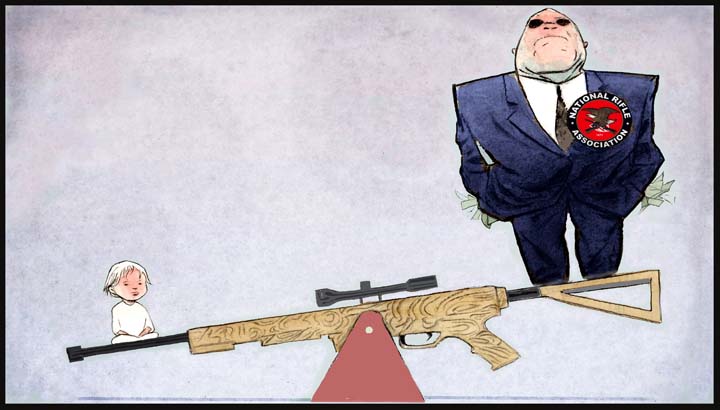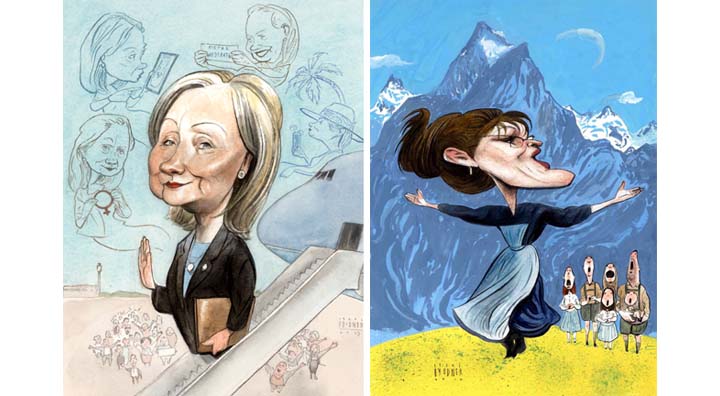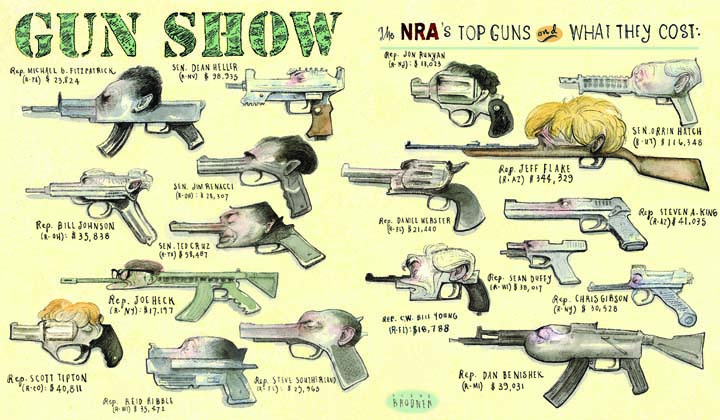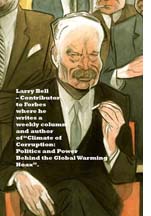Steve Brodner on Political Animals
With the political campaign season in New York City getting off to a rumbling, if somewhat stumbling start, I emailed Steve Brodner yesterday to get an update on what makes making fun of politicians such an important part of the social order:
Q: The people who inhabit your narratives are primarily alpha-male power-trippers. Why do you find these characters so fascinating? Have you been able to detect when a powerful figure is on terrain that dangerously borders corruption?
A: I have spent my career basically addressing issues of power in the US. Which big dogs get to eat first and most? I ask the age-old question: how can we strip away veneers, trappings, poses and get down to the "transaction." What's the deal? What motivates the end result? I don't start with the pols. I start with the issues, the results of the power relationships. In other words, the pain. Then follow the line starting from the pain and follow it right up to . . . the ugly old men.
If you start with the blood of Newtown, or Iraq it will lead right to a sparkling, richly appointed, deeply carpeted office in Washington or Wall Street. Find that guy. Draw him. Show Wayne LaPierre, Dick Cheney. Make them as clearly what they are as you can. They will remain powerful, let's face it, no matter what you do. But the fact that you do this, satirize and point the finger at the unindicted criminal, the more you are fulfilling your function. The attempt by journalism to tell truth on fools and the greedy in power is a sacred responsibility. And you cannot measure how many heads turn and opinions change because of voices in the media. But change we do. It is a great joy to be part of that.

Above: Gun See Saw (art for video being produced for Mayors Against Gun Violence).
Q: Who is the most powerful female politician or leader you have delineated? Was Sarah Palin interesting enough for you? If not, what, in your eyes, dragged her down?
Thatcher was. But she was the province of the British press and Steadman, Scarfe, Fluck and Law, et al got right on the job. In the last 20 years it is undoubtedly Hillary Clinton. She was powerful from day one. I saw the Clintons at a presser in New York at the Democratic Convention in 1992. They, together, are a political tsunami. The campaign has begun, by the way. Hold on to your hats.
Sarah Palin was, in many ways, one of the great curiosities of American politics; like Ross Perot. There had never been anything like her. She was Annie Oakley, Mata Hari, Mr. Smith, Will Rogers, Oprah Winfrey, Lonesome Roads, all at once. She arrived with the (unwarranted) self-confidence of ten people. And through sheer charisma and bluster talked her way nearly to the White House! What tripped her up was the fact that she was missing the important component of intellectual curiosity and rigor, which, in the smallest degree, would have made her able to govern and even discuss governing. Today you truly need to master all those skills. Luckily for the country, she didn't have them and is now gone. But she is a fantastic play/movie waiting for David Mamet or Tony Kushner.

Left: Hillary Arrives Home, The Washingtonian, Michael Goesele, AD, Garrett Graff, Ed. Right: Sound of Sarah, The New Yorker, Chris Curry, AD, Davis Remnick Ed.
Q: American magazines seem be hooked on info-graphics. Do you see anything that looks like a trend? Or any reason why Americans like to have their data dissected and spliced back together again?
A: Is this a particularly American need do you think? I don't know. I think that what might be going on is that we have an overload of information and data. The feeling perhaps is that more we can shape it, the more we can absorb. And yeah, perhaps the less time we might have to spend deciphering it. That's the part of this I'm not especially comfortable with. I think we need to find space. Space to cook slow food. Space to read long books, long-form articles in magazines.
The data rush, after a while, impresses one with its inherent emptiness. The data we put into an recognizable shape may be more easily grasped at once, but is perhaps much less sticky. What is sticky is when you read a very well written piece about a place, organization, person you never considered before and then emerge with the sounds, feelings, flavors having made an impact. You feel you've been there, met the people. I don't think that happens with a single image. But with multiple images, tied together in a way that makes sense, you might come closer.

Above: Gun Show, The American Prospect, Mary Parsons, AD, Kit Rachlis, Ed.
Q: What are the top three subjects of debate in America today that consume your interest?
A: There are many. But they all lead back to the inability of the system to function anymore. We are lucky that the previous generations have put the country in so powerful a place that, for a while, it no longer had to cut a course for itself in the world. There is no superpower to challenge it militarily or, for now, economically. But without the ability to course-correct, have vision as, say Truman did with the Marshall Plan, and invest in the future, the sun will start to set.
 You can see this in our
inability to invest in education, where our students rank very low now in the world. We can't get upset about torture, drones, inequality, hunger in America. We used to be able to have
dialogue about these things, but that's over. We are stuck because the powerful have figured out how to gum up the system and make it stop working. It also has diluted the power of the media, which
consolidates into just a few companies who care only about profit. Even people who love to watch Kardashian get married again are aware that they are being ripped-off. And it is in that gap
that the Koch Brothers, Sheldon Adelson, Trump etc. can dive in and eat all they want.
You can see this in our
inability to invest in education, where our students rank very low now in the world. We can't get upset about torture, drones, inequality, hunger in America. We used to be able to have
dialogue about these things, but that's over. We are stuck because the powerful have figured out how to gum up the system and make it stop working. It also has diluted the power of the media, which
consolidates into just a few companies who care only about profit. Even people who love to watch Kardashian get married again are aware that they are being ripped-off. And it is in that gap
that the Koch Brothers, Sheldon Adelson, Trump etc. can dive in and eat all they want.
Climate Change is the saddest example. We don't need more proof of this. The South is burning. The coasts are flooded. Six-thousand-year-old glaciers are gone in 20 years. And yet where is the debate, the legislation, the action? It seems we are just going to ignore this in the same way that we just let inequality continue. But climate change will not obey class distinctions. We will all fry together until we start to take action. And that we must do. One small thing we can do as artists is to draw pictures about it.
Left: Detail from The Mad Men of Climate Change, work in progress, The American Prospect, Mary Parsons AD, Kit Racklis Ed.


